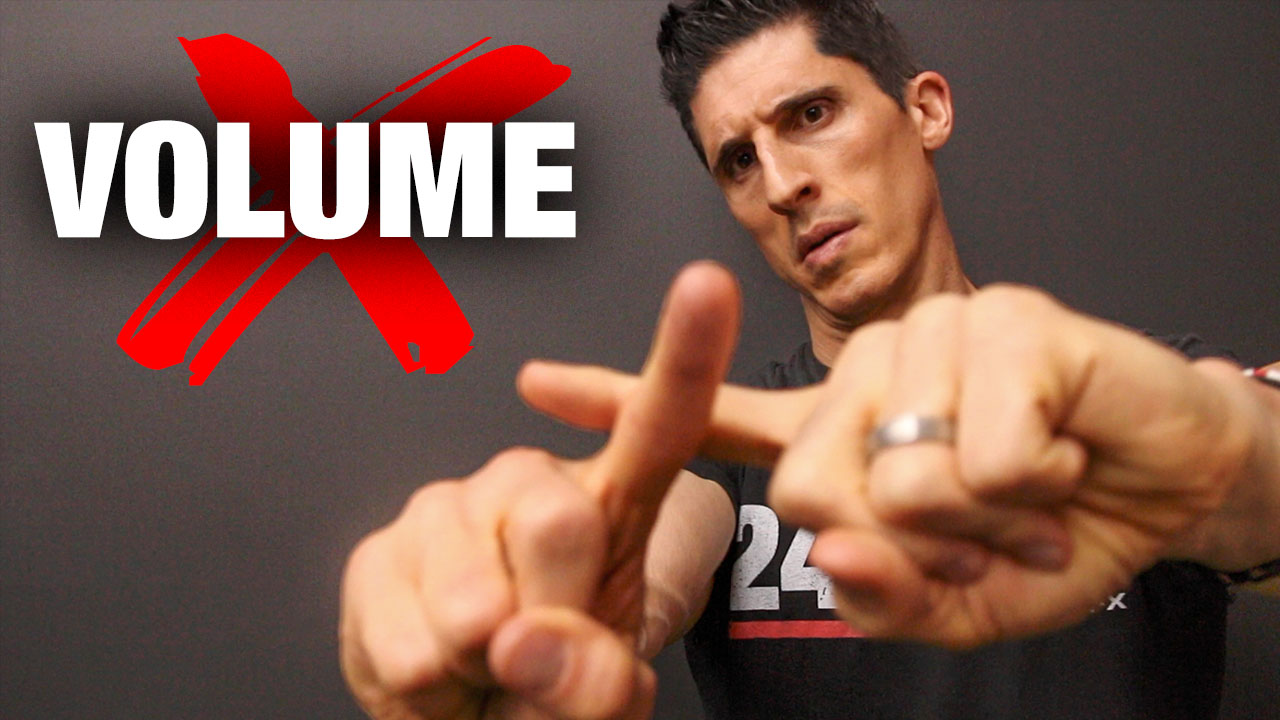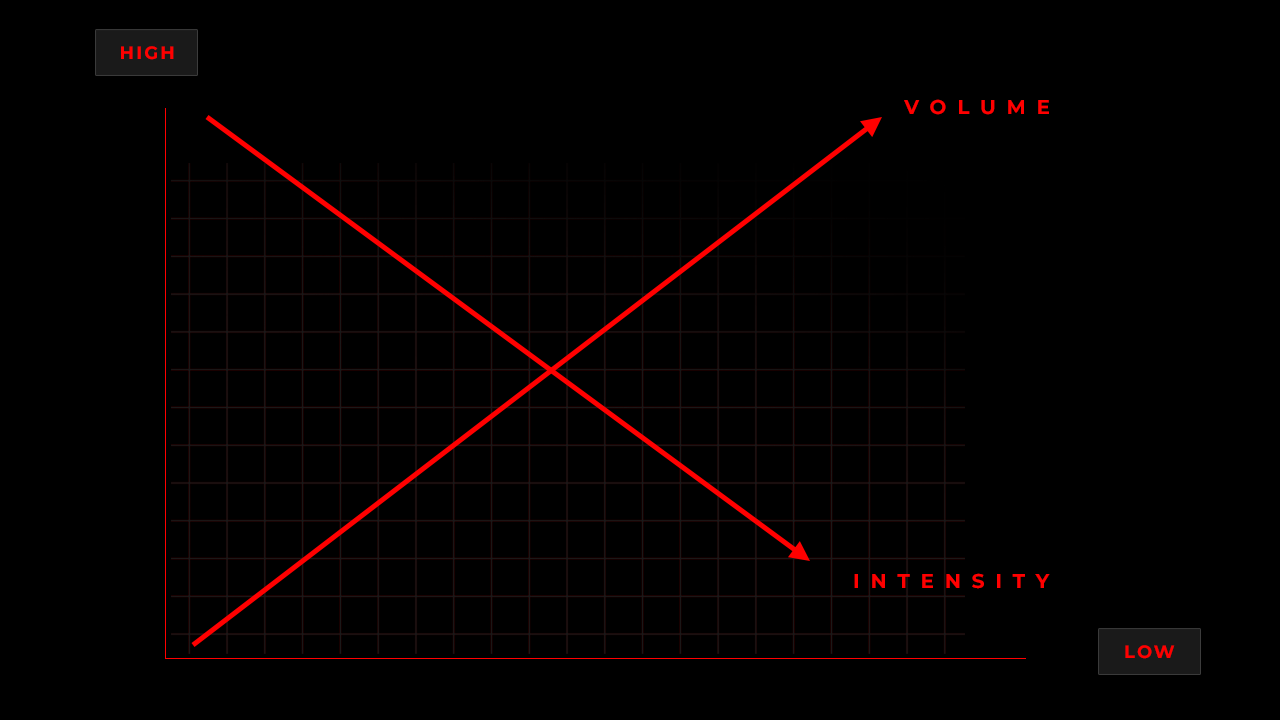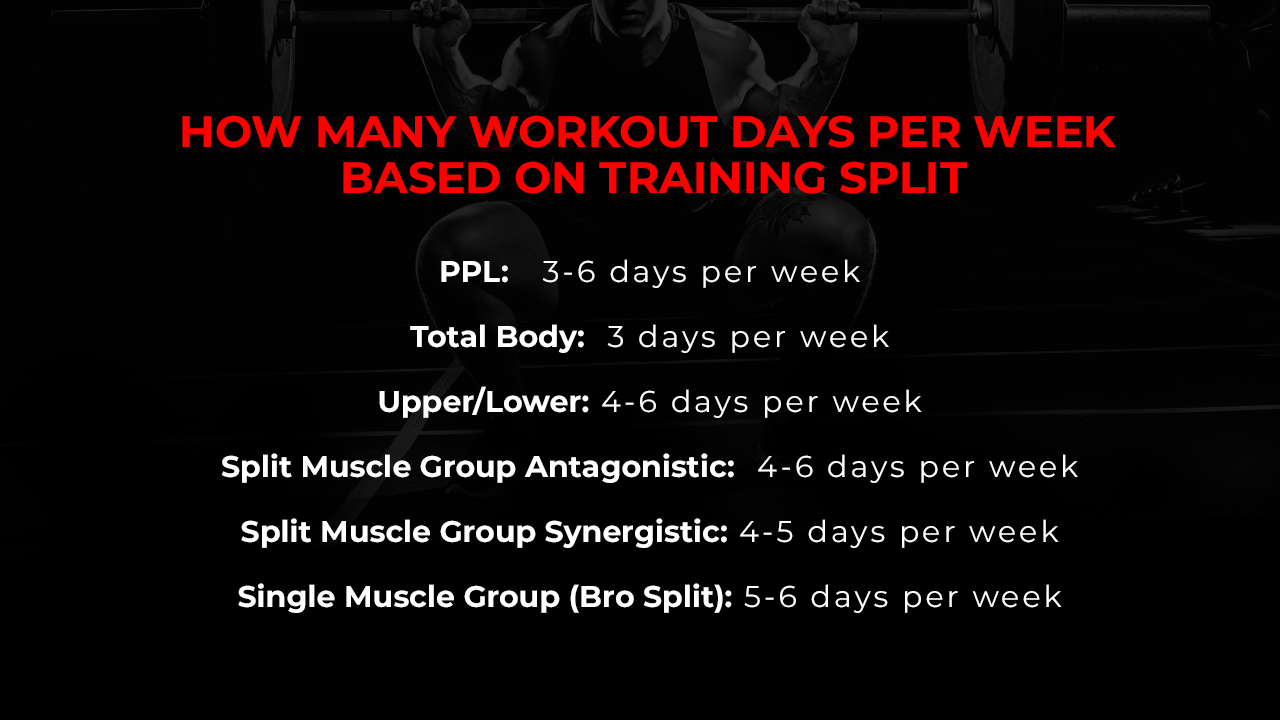
WHAT’S THE BEST WORKOUT FREQUENCY?
You want bigger biceps, powerful pecs, and tree-trunk legs. Your current workout isn’t getting you these things so what do you do?
Work out more, right? Wrong!
If there’s one decision that can singlehandedly halt your progress and send you backward on the road to your ideal physique, it’s this.
Guys, more workouts don’t necessarily mean more (and better) results.
What it could mean is burnout, fatigue, over-training, muscle loss, and injury. And no one wants that.
So, the question is, “How many times a week should I work out?”
Let’s take a look at your experience with fitness, individual goals, and the type of training you’re doing, because all these factors are important.
We’ll also dive into the essential role that the right amount of intensity has in these strength training sessions.
WHAT DETERMINES WORKOUT FREQUENCY?
Right now, you’re thinking, “Jeff, how many days per week should I work out?”
The short answer to that is, “It depends.”
The number of workouts per week of strength training will depend upon a few key factors including:
- Current fitness level
- Fitness goals
- Type of training split
Individual goals matter a lot! For example, a beginner with a fitness goal of muscle hypertrophy who is doing a push-pull-legs split will have a much different training program than someone who is experienced and training to be a powerlifter.
And then we have to consider the occasional “exception to the rule” such as your abs, since you can safely train those almost every day of the week.
Before we review each of those factors, I want to discuss the relationship between homeostasis, volume, and intensity – all factors that directly influence how many days you should work out.
FIGHTING HOMEOSTASIS
Most of us hate change, and we feel very comfortable in our own little routines.
Your body is the same way! It strives for what is called homeostasis, which is a big word that means no change.
It constantly seeks homeostasis, and it will adapt to your current environment and stimuli to make those the new norm.
When you’re trying to elicit a change, such as getting a muscle to grow, the body prefers just the right amount of stimulus to provoke what we see as an improvement. In this case, you notice more muscle.
In reality, your body is seeking an adaptation so that the next time it experiences this stimulus, it can better fend for itself and resist yet another change.
We are trying to force change on our bodies with every workout and our bodies are trying to keep things status quo.
Guess who wins most of the time?
To make things worse, a lot of people will see that they aren’t getting results – that the body has entered a plateau – and they will decide to work out more.
They’ll use the same intensity and volume, but the difference is that they’ll just do it longer or for more days.
And this is where you totally ruin your chances to see progress.
Thankfully, there’s a better way to restructure your workout schedule so you don’t have to spend hours upon hours, days upon days in the gym.
It all has to do with intensity and volume.
INTENSITY VS. VOLUME
Continuing with the example above, a lot of guys will not see the results they want and assume it has to do with the number of sets and reps they are doing.
In response, they will dramatically increase these acute variables to a point that is downright insane, such as 24 sets per muscle group!
I don’t care who you are, if you’re a natural lifter and you’re adding that kind of volume to your program, something is going to suffer.
The quality of the sets that you’re doing is going to go down over the course of that workout.
What might have been good in the first several sets is not going to look the same way when you get to set number 16. And certainly not when you get to set number 24.
Most importantly, there is no way that you can maintain a high level of intensity for each and every one of those sets. Not naturally anyway.
This is what I like to call “junk volume.”
And this perfectly illustrates the lie that most of you have been fed:
If you increase volume, you need to decrease intensity. And if you increase the intensity, you need to decrease the volume. It’s not that simple, guys.
Sure, volume is important, but what’s more important is high-quality intensity.
The irony is that research shows you really don’t need that many quality sets to create muscle protein synthesis.
As you probably already know, protein synthesis is the spark for muscle hypertrophy. You need somewhere between 4 to 10 sets of high-quality work per muscle group.
I can’t stress this enough: High quality has nothing to do with volume.
The quality is driven by the intensity of the exercise.
And the way to tap into good, old-fashioned intensity is to truly train to failure. And as I just mentioned, you don’t need a ton of sets and reps to do that.
HOW TO TRAIN TO FAILURE
Too many people have been told that in order to train properly, they better watch out for the intensity of their training.
They’re told if they train to failure, they’re going to interrupt the body’s ability to recover 48 hours later.
They’re told that they are going to create too much damage and too many problems.
So, what happens is they stick to a moderate-intensity exercise and hold back in the number of repetitions they perform as they approach failure.
In other words, they stay below failure. They feel like it’s getting too difficult, so they take an interval of rest before doing another lackluster set.
And guess what? That’s not true muscular failure.
What’s happening is the intensity is suffering so much.
These people are told that they’re doing the right thing by adding more and more volume. Unfortunately, their intensity is not adequate to create change.
That’s a problem.
WHAT IS MUSCULAR FAILURE?
Let’s talk about muscular failure, the moment when you’ve pushed your muscles to their absolute limit.
It’s the point where you’ve given it your all and your muscles just can’t take it anymore. You’re sweating, you’re breathing hard, and you’re feeling that sweet burn.
It’s that magical moment when you know you’ve given it everything you’ve got and left nothing on the table.
Are you really even training to true, momentary, concentric failure?
This means you truly cannot lift this thing for one more rep. You go all the way, as hard as you can until you can’t lift it anymore.
Is that actually happening, or are you stopping just because it’s getting difficult?
If I had to bet, I’d say a lot of you are stopping short. Most of you aren’t realizing your true potential. Instead, you’re stopping because the exercise is getting a little tough.
And here’s the thing: You don’t need heavy weight to reach muscular failure.
You need intensity. Results are not driven by volume if there’s no presence of intensity.
There’s an epidemic now of too much junk volume out there and I want to give you tips to make sure you’re not falling into this trap.
Training to complete muscular failure can be an effective way to stimulate muscle growth and improve strength.
Here are some tips for training to complete muscular failure:
WARM-UP PROPERLY
Before starting your workout, perform a dynamic warm-up to increase blood flow to your muscles and prepare your body for the upcoming stress.
Aerobic activity followed by light movements that mimic the exercises you’ll be doing can help prevent injury and improve overall performance.
Aim for about 10 minutes of warming up with light aerobic exercise and dynamic stretches.
USE A SPOTTER
When training to failure, it’s essential to have a spotter, especially when performing compound exercises like the bench press, squat, or shoulder press.
A spotter can assist you when you reach your limit and help prevent injury from losing control of the weights.
USE DROP SETS
Drop sets are a popular and effective training technique for pushing your muscles beyond their usual limits, promoting muscle growth and endurance.
This method involves performing a set of an exercise to failure or near failure, then immediately reducing the weight and continuing to perform additional reps until failure is reached again.
Drop sets are a good reason to have a spotter nearby as activity levels can be really intense.
LISTEN TO YOUR BODY
Training to failure requires you to have a strong mind-to-muscle connection especially during weight-bearing activities.
That means you need to feel what’s going on inside the muscle, so you know whether to increase the weight or pump out another five reps.
During vigorous activity like a drop set, listening to your body will help you know whether you’ve truly achieved failure.
HOW MANY TIMES A WEEK SHOULD I WORK OUT?
With all that said, now that you know how to work out, it’s time for a solid number of days of strength training.
The catch is that I’m going to break this down based on two key factors: experience with fitness and type of training.
These training recommendations will also focus on strength training exercises and how many days you should find yourself in the weight room or in your home gym.
FITNESS LEVEL
Here’s how many workout days you should consider based on your fitness experience level and your exercise history.
BEGINNER
If you’re new to working out or just getting back into an exercise program, it’s best to start with three days of exercise per week.
This allows your body to acclimate to the new physical demands and reduces the risk of injury.
I’d recommend focusing on a mix of strength training with cardio.
This mixture of weight training with moderate-intensity cardio activity is going to do a lot for basic health and fitness.
More specifically, as a beginner, you get to reap all the benefits simultaneously including lean muscle building and weight loss.
Perform full-body workouts three days per week with one day or two days of cardio per week. This will help you build a solid fitness foundation.
INTERMEDIATE
As an intermediate fitness enthusiast with some experience under your belt, you can aim for three-to-four days per week.
This allows for a balance between training and recovery, while still providing enough stimulus for progress.
You may choose to continue with full-body workouts or transition to a split routine, depending on your goals and preferences.
Again, save a day or two for cardiovascular exercise, but only if it makes sense for you. You can opt for moderate-intensity physical activity, which will require more minutes of exercise.
Or you can go for something that has more intensity and takes less time like high-intensity interval training.
ADVANCED
For advanced fitness pros who have been training consistently for an extended period, five or six exercise days per week can be beneficial.
At this stage, you may need a higher training frequency – along with increasing workout intensity – to continue seeing progress.
Your plans will probably incorporate a mixture of heavy weights with moderate weights along with varying workout length. This will depend on how hard you’re working that day.
This is especially true if you’re following a split routine, which targets specific muscle groups each day.
Again, your intensity is high throughout each and every workout, regardless of the total time.
Remember, though, that adequate recovery and rest days are still crucial to avoid overtraining and injury.
TYPE OF TRAINING
Here’s how many days per week you should consider exercising based on the type of training you’re doing.
PUSH-PULL-LEGS (PPL)
We kick off our list with one of the most popular muscle splits: Push Pull Legs or PPL.
For a Push-Pull-Legs routine, you can aim for three or six days per week. Here’s how:
You can do each workout once per week (three days total) or twice per week (six days total) depending on your level of fitness, recovery abilities, and goals.
Naturally, if you’re a beginner, I’d say to stick with three days per week for this exercise routine. You can throw in some moderate-intensity aerobic exercise in between the days for strength training.
If you’re a more advanced trainee, you can try out the six-day training schedule.
If you’re doing the six-day schedule, most people will have a rotating day off that falls between the two PPL blocks.
For example, if you finish the first block with a legs workout on Wednesday, you would take Thursday off then perform the push workout on Friday. Your next day off would be Monday.
TOTAL BODY
With a total body workout (or full-body workout), the focus is on compound movements with cardiovascular exercise sprinkled in between.
The type of exercise you tend to do will involve squats, bench presses, deadlifts, overhead presses, and other compound movements. In other words, you’re looking at intense full-body workouts for each of your strength training days.
For total body workouts, it’s generally recommended to work out three to four days per week.
This allows for adequate recovery and days of rest between sessions while still providing enough stimulus for progress.
Again, beginners should stick with three days per week while those with experience can throw in one more day.
Beginners will see the most results from this type of program because they’ve never done weight training for lean muscle mass before. What’s more, they are hitting every major muscle group three times per week.
Don’t forget to include some moderate-intensity aerobic physical activity in between those strength training days.
The muscle gains are going to surprise you if the most physical activity you’ve ever done involved just your body weight.
With that said, keep in mind that muscle will not keep growing over time unless you make a plan to keep challenging yourself.
You need to keep cycling through periods of time where the acute variables – sets, reps, etc. – are new and challenging.
Muscle growth happens because the intensity is paired with the ideal weekly workout plan.
UPPER/LOWER
As the name suggests, this type of split separates the upper body and lower body into their own strength sessions.
For an upper/lower split, you can go between four and six workout days per week, alternating between upper and lower body workouts.
For example, one of your days of training for the upper body might look like this:
- Chest Presses
- Lat Pulldown
- Chest Flies
- Landmine Rows
- Leg Raises
- Cable Crunch
This ensures each muscle group gets trained for two sessions per week while allowing for recovery days.
It also ensures you can squeeze in some cardio exercise.
Cardio activity could include interval training such as high-intensity interval training, which is an effective workout that also saves time.
Beginners should first complete a total body or PPL workout routine for at least two months before moving to an upper/lower split.
If you have a lot of experience under your belt, you can try alternating these strength workouts six days per week, giving yourself one glorious rest day.
SPLIT MUSCLE GROUP – ANTAGONISTIC
An antagonistic split muscle group routine means that you’re working out muscle groups that are in direct opposition to each other.
For example, the following muscle groups are antagonistic:
- Chest and back
- Quads and hams
- Biceps/triceps
A series of exercises might include a Barbell Bench Press followed by a Bent Over Row.
When following an antagonistic split muscle group routine, you can work out four-to-six days per week, assigning one muscle pairing per day.
Again, I’d recommend that beginners hold off doing this type of workout until they’ve done a total body or full-body workout with a balance of cardio exercise for a couple of months.
SPLIT MUSCLE GROUP – SYNERGISTIC
On the opposite side of the spectrum, the synergistic muscle pairings include muscles that work together such as chest and triceps, back and biceps, and hams and glutes.
For a synergistic split muscle group routine, aim for four-to-five days per week.
SINGLE MUSCLE GROUP
You might wonder if I suggest a Bro Split, and my answer is, “Depends on the Bro Split.”
Guys, there is a way to do a Bro Split correctly.
However, unless you’re a bodybuilder, I might initially steer you away from the Bro Split, especially if you’re a beginner.
With that said, if you’re doing a Bro Split like I discuss in my article on the best workout split, then I’d say you can work out between five and six sessions per week.
ROLE OF NUTRITION
There’s no way I can talk about how many times a week to work out without mentioning nutrition. After all, without good nutrition, your strength workouts won’t produce any results.
The deal is, we can all trick ourselves into getting to the gym for an hour a few times a week.
But the real work happens during the other 23 hours when you’re supposed to be following a solid nutrition plan and sleeping between seven to nine hours.
In other words, training is easy compared to nutrition and sleep.
The responsibility is so much greater and that’s why so many people struggle with nutrition.
It is essential to understand that nutrition plays a pivotal role in achieving your fitness goals. Proper nutrition can help support muscle growth, maintain a healthy weight, and fuel your body with the energy it needs to perform at its best.
Below are some fundamental guidelines to keep in mind as you plan your workout program.
NUTRIENT BALANCE
Incorporating a balanced diet consisting of carbohydrates, proteins, and fats is crucial.
Carbohydrates provide the energy needed for your workouts, while proteins aid in muscle repair and growth.
Fats, on the other hand, are essential for hormone production and overall health.
TIMING OF MEALS
Eating at the right times can make a significant difference in your progress.
Consuming a meal or snack containing both protein and carbohydrates within 30-to-60 minutes after your workout can help with recovery and muscle growth.
Unless you’re following a specific fasting or meal timing schedule, try to eat a well-balanced meal every three to four hours.
HYDRATION
Proper hydration is vital for optimal performance in the gym and overall health.
Drinking enough water throughout the day isn’t enough though. You also need electrolytes.
This can help to regulate body temperature, maintain proper digestion, and prevent fatigue during your workouts.
MEAL PLANNING AND PREPARATION
Taking the time to plan and prepare meals in advance can make it easier to stick to a healthy diet. This can also save you time and money.
CHOOSE WHOLE, UNPROCESSED FOODS
Prioritize consuming fresh fruits, vegetables, whole grains, lean proteins, and healthy fats over processed and sugary foods.
PORTION CONTROL
Be mindful of your portion sizes, as eating too much of even healthy food can lead to weight gain and hinder your progress.
ACCOUNTABILITY
Enlist the support of friends, family, or a professional nutritionist to help keep you accountable and motivated.
“How many times per week should I work out?” It’s an important and, admittedly, annoying question.
It’s all going to depend on your fitness level and type of training, but assuming you’re getting at it and revving up that intensity, here’s a quick wrap-up:
Beginners should focus on three days per week, intermediate lifters can lift between three to five days per week, and advanced lifters can go for four to six days each week.
Don’t have an exercise plan to follow or maybe you’re looking to change up your current one? We can help! Check out our ATHLEAN-X training plans to see which one is the best fit for your goals and fitness level, regardless of where you are in your fitness journey. Let me be your personal trainer and strength coach and you’ll be amazed at your results.

- How many days you should work out will depend upon a few key factors including fitness experience, fitness goals, and types of exercise or training split.
- First, you want to make sure you understand that the focus during your training should be on the intensity – not the volume.
- You don’t need much volume to trigger protein synthesis, but you do need high-quality intensity. Training to muscular failure ensures you’re able to achieve this intensity.
- As far as how many times a week you should work out, you should consider your fitness level. Are you a beginner? Three days per week will be good for you. Intermediate and advanced lifters can opt for longer training weeks at three to five and four to six, respectively. More training days does not mean you should skip on the intensity.
- Next, consider what type of training you are doing. Thankfully, you’ll realize that the type of training that’s right for you usually coincides with experience with fitness.
- For example, a beginner should start with the total body workout, which should be performed three days per week.
- Other workouts like the Push-Pull-Legs (PPL) and split muscle group workouts can be done between three and six times per week.
- Don’t forget to support these intense workouts with good nutrition and plenty of sleep.
HOW MANY TIMES A WEEK SHOULD I WORKOUT FAQS
This depends on your fitness level and type of training. If you are a beginner, I’d recommend exercising three days per week.
If you have some experience, try lifting between three and five days each week. If you’re an advanced lifter, go for four to six days a week.
For general fitness, aim for at least 150 minutes of moderate-intensity aerobic exercise or 75 minutes of vigorous-intensity aerobic exercise spread out over three to five days per week.
Additionally, perform strength training exercises targeting all major muscle groups at least two days per week.
Adjust your workout frequency based on your specific fitness goals and listen to your body to avoid injury or burnout.
REFERENCES

Jeff Cavaliere M.S.P.T, CSCS
Jeff Cavaliere is a Physical Therapist, Strength Coach and creator of the ATHLEAN-X Training Programs and ATHLEAN-Rx Supplements. He has a Masters in Physical Therapy (MSPT) and has worked as Head Physical Therapist for the New York Mets, as well as training many elite professional athletes in Major League Baseball, NFL, MMA and professional wrestling. His programs produce “next level” achievements in muscle size, strength and performance for professional athletes and anyone looking to build a muscular athletic physique.






































